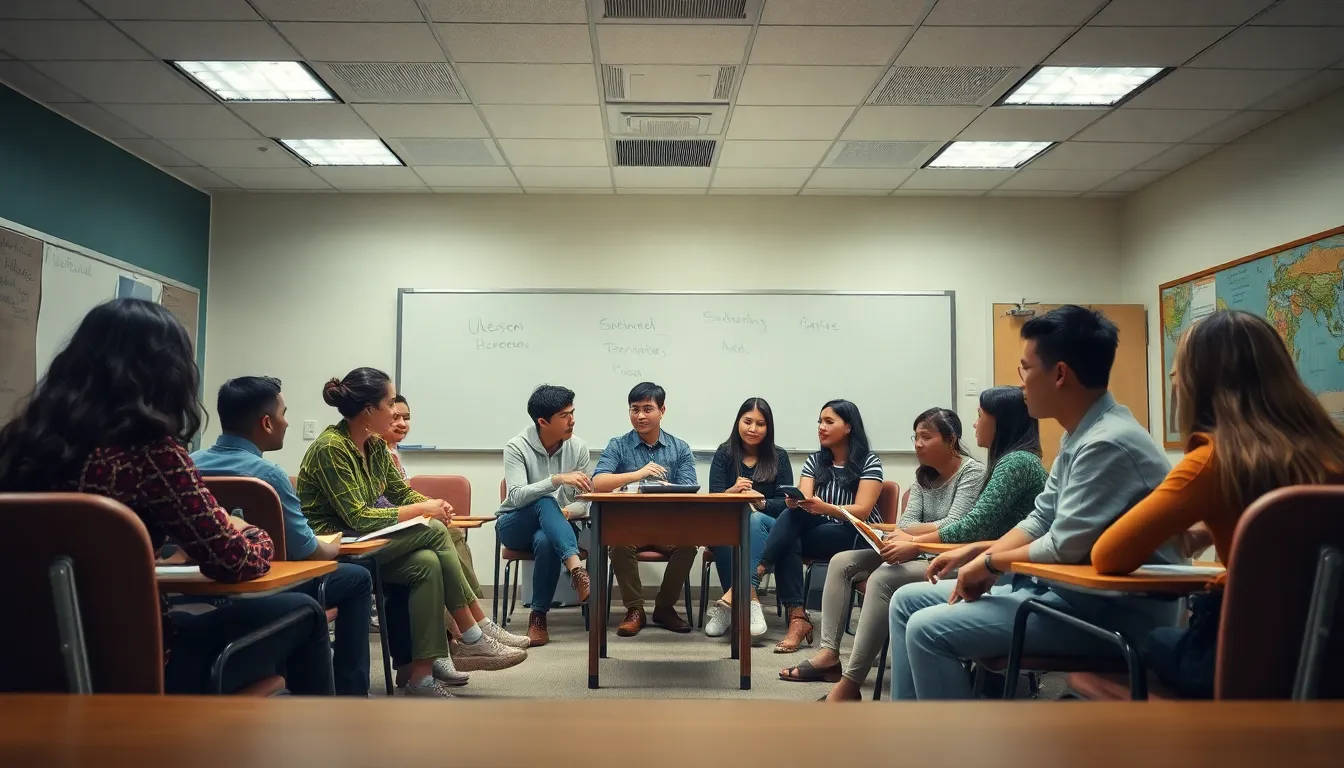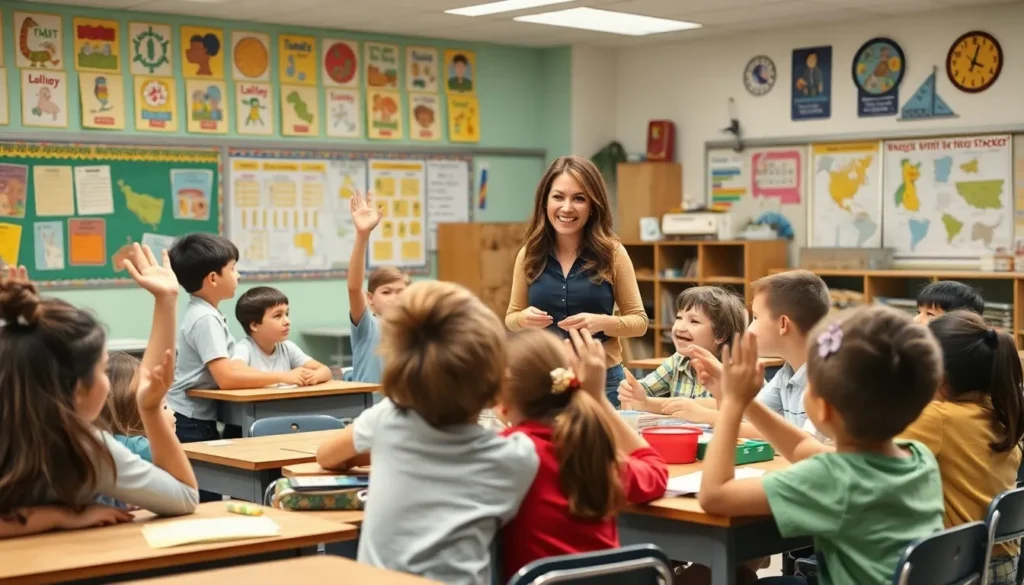In the vibrant world of education, classroom behavior can sometimes feel like a circus—complete with clowns, acrobats, and the occasional lion tamer. Navigating this lively atmosphere is crucial for teachers and students alike. After all, a well-managed classroom can transform chaotic moments into productive learning experiences.
Table of Contents
ToggleUnderstanding Classroom Behavior
Classroom behavior encompasses the actions and interactions of students within a learning environment. These behaviors can significantly influence educational outcomes. Effective classroom management identifies desirable and undesirable behaviors, allowing teachers to address issues proactively.
Active participation stands as a critical component of positive classroom behavior. Engaged students are likelier to contribute to discussions and collaborate with peers. Communication skills develop through consistent interaction, giving students confidence in expressing their thoughts.
Control strategies, such as clear expectations and consistent routines, foster an orderly atmosphere. Establishing rules provides students with a framework for acceptable behavior. Reinforcement of positive behavior encourages students to maintain their focus.
Disruptive behavior, including talking out of turn or inattentiveness, detracts from the learning experience. Identifying triggers can help educators tailor their approaches. Understanding the reasons behind such behavior allows for constructive interventions.
Social dynamics within the classroom also play a pivotal role. Peer relationships impact motivation and engagement, making it essential to promote a supportive environment. Encouraging collaboration not only mitigates negative behaviors but also enhances the overall learning process.
Teachers can employ various strategies, including interactive lessons and group activities, to maintain student interest. Incorporating technology and hands-on projects keeps students engaged and reduces instances of misbehavior.
Assessment of classroom behavior should include feedback from students, facilitating continuous improvement. Gathering insights helps educators refine their management techniques. A focus on understanding classroom behavior leads to a more harmonious learning experience for everyone involved.
Factors Influencing Classroom Behavior

Various elements impact classroom behavior significantly. Understanding these factors can enhance management strategies and lead to better educational outcomes.
Teacher Influence
Teacher actions and attitudes shape student behavior profoundly. An engaging teaching style captures student attention, fostering a positive atmosphere. Clear communication of expectations sets standards for behavior. Supportive feedback encourages participation and minimizes disruptive actions. When teachers model respect and kindness, students often mirror these behaviors, creating a respectful environment conducive to learning.
Peer Interactions
Peer relationships play a vital role in shaping classroom dynamics. Strong friendships can foster motivation and engagement among students. Conversely, conflicts can lead to distractions and disruptive behavior. Social skills developed through group activities enhance communication and collaboration. Encouraging positive peer interactions helps reduce misconduct while promoting a sense of belonging and teamwork within the classroom.
Environmental Factors
Classroom layout and resources influence student behavior significantly. A well-organized space minimizes distractions and fosters focus. Adequate lighting and comfortable seating contribute to overall well-being. Access to appropriate technology and learning materials enhances engagement and reduces frustration. Creating a welcoming environment supports positive behaviors and encourages collaborative learning among students.
Strategies for Managing Classroom Behavior
Effective strategies play a vital role in managing classroom behavior, enhancing the overall learning environment. The following approaches address preventive measures and techniques for intervention.
Preventive Strategies
Establishing clear rules creates a foundation for expected behaviors. Engaging students in the creation of these rules fosters ownership. Incorporating routines helps to minimize confusion, guiding students through daily activities. Regularly reinforcing positive behaviors encourages students to continue those actions. Utilizing student interests in lesson plans captures attention and inspires participation. Creating an inviting classroom atmosphere promotes a sense of belonging, which can reduce disruptive behavior. Building relationships with students encourages open communication, making them feel valued and heard.
Intervention Techniques
Addressing disruptive behavior promptly prevents escalation. Implementing one-on-one conversations with students helps identify underlying issues. Utilizing behavior charts provides visual feedback, allowing students to track their progress. Involving parents in discussions about behavior can promote consistency between home and school. Offering alternative activities during moments of restlessness redirects energy in a constructive way. Teachers can model appropriate behaviors, demonstrating expectations through their actions. Establishing a support system for students needing extra help fosters a sense of community and encourages positive interactions.
The Impact of Classroom Behavior on Learning
Classroom behavior significantly influences learning outcomes. Positive behaviors promote engagement while negative behaviors disrupt the educational process. Teachers who establish clear expectations create an environment conducive to effective learning. Students thrive when they understand acceptable behaviors and their importance in a classroom setting.
Peer interactions also play a crucial role in shaping behavior. Strong friendships can enhance motivation and collaboration among students. Conversely, conflicts may lead to distractions, hindering academic progress. A supportive classroom atmosphere encourages positive peer relationships, thus fostering a better learning environment.
The classroom layout affects behavior management as well. An organized space enhances focus and reduces distractions. Resources should be accessible, ensuring that students can engage with the material effectively. A well-structured environment aids in maintaining student attention.
Incorporating interactive lessons keeps students interested and engaged. Teachers utilizing technology often see a decrease in misbehavior, as modern tools capture students’ attention. Active participation encourages students to invest more in their education.
Understanding disruptive behaviors is vital for implementing effective interventions. Teachers must identify triggers to address issues constructively. Engaging in one-on-one conversations with students can reveal underlying problems affecting behavior.
Feedback from students provides valuable insights into classroom dynamics. Regular assessments of behavior help teachers adjust strategies to create a harmonious learning environment. Prioritizing positive behavior reinforcement leads to improved academic performance.
Managing classroom behavior is essential for creating a productive learning environment. When teachers implement effective strategies and foster strong relationships with students, they can significantly enhance engagement and motivation. Understanding the dynamics of behavior allows educators to address challenges proactively and create a supportive atmosphere.
By promoting positive interactions and maintaining clear expectations, teachers can transform potential disruptions into opportunities for growth. Regular feedback from students is crucial for continuous improvement, ensuring that the classroom remains a place of collaboration and respect. Ultimately, a well-managed classroom not only benefits academic performance but also nurtures the social and emotional development of every student.










